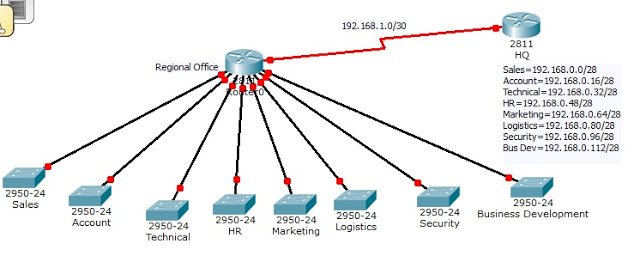One of the topics young network engineers as well as aspiring network associates struggle to understand is route summarization. To explain this topic, I will be using a detailed example just like I do when I teach students on CCNA or MTCNA. I will assume we have eight subnets for our eight departments connected to our regional office router, and the regional office router needs to advertise these eight sub networks to the headquarter office router. An inefficient way of doing this, is to have these eight networks advertised individually from the regional office to the headquarter office. When you do this, it will not only bloat the routing table of the headquarter router, it will also slow down the time it takes for the headquarter router to route through its routing table. The most efficient way to advertise these subnets is by using a single route statement with a summary mask that captures the eight subnet. See below.
Route summarization
From the diagram above, we have eight sub networks connected to the regional office router. These subnets are to be summarized in a route advertisement to the headquarter router. First, we need to get the summary mask for the subnets. This is where most students find it difficult but believe me, it is very easy. When you take a look at the the eight subnets, the difference comes in the last octet. They all have 192, 168, and 0 in the first, second and third octets respectively. Since the difference is in the fourth octet, we need to get a mask that will summarize the difference in the fourth octet into a single network address. The last subnet ends at 192.168.0.127 making 192.168.0.128 the next subnet. Now, to effectively summarize these subnets, we need a mask that can capture from 0 to 127 so that we can advertise them as a single subnet. The question is, what value can we have in the fourth octet of a subnetmask so that if we minus it from 256, we will have 128? the answer is 128,i.e 256-128=128. This leaves us with the subnetmak of 255.255.255.128. Our summary address for the subnets listed above is 192.168.0.0/25. /25 was gotten from 255.255.255.128.
A single eigrp advertisement statement using this summary address will be: ip summary-add eigrp 10 192.168.0.0 255.255.255.128 while that of ospf will be: area 1 range 192.168.0.0 255.255.255.128
It is that simple and straight forward. Feel free to leave a comment on a any topic you need clarifications on. Thanks for reading and don’t forget to like our page. Stay safe.



Dear Sir,
this is what i am searching about it but the command which you have used is for Cisco devices not for Mikrotik how can we summarize our network if i have four /24 prefix and want to summarize it in the network and i am using Mikrotik as a main router and used RIPV2 protocol in network and have configure on every port of Cisco switch a separate vlan.
you can reply me on my atiq1458.afgs@gmail.com email address also.
waiting for your kind corporation.
Having sent a reply to this blog visitor, I thought it will be nice to share my reply so that any one having a similar issue can connect. Be free to drop your own contribution, after all, there are many ways to get a task done. My reply:
Dear Blog visitor,
I read through your question on my blog, TimiGate and I am more than happy to help.
Since you have four class C subnets of /24, I suppose you have 192.168.0.0/24, 192.168.1.0/20, 192.168.2.0/24, and 192.168.3.0/24, that is if your network was designed with summarization in mind.
To summarize these subnets into one and send to an RIP2 neighbor, we will use 192.168.0.0/22, (again, I suppose you already know how to get your summary address.)
Next, you create a prefix list. Click on routing and then click on prefix lists. Enter a name for the prefix lists and enter the summary address (192.168.0.0/22) above in the space for prefix, click on apply and ok.
Next, click on routing, choose RIP and click on add. Choose the RIP version you are running and choose the interface you want the summary address advertised out of, in the space for "out prefix list", choose the prefix list we created above, apply and Ok. Thats all. Let me know if you need any more help.
Thanks for visiting TimiGate and please do visit again